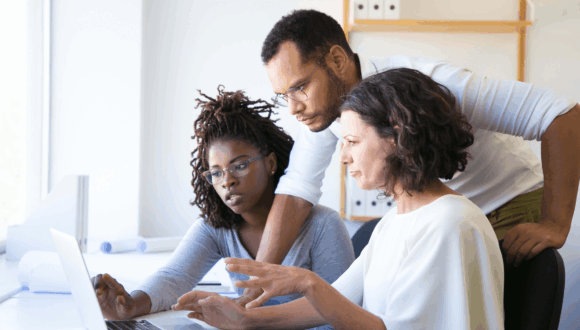Key Takeaways
- Strong sales messaging frameworks give reps repeatable plays, so they stop winging it and start leading consistent, buyer-relevant conversations that drive more meetings, faster closes, and revenue growth.
- When messaging is tied to real buyer signals and business outcomes, teams stop guessing and start scaling what works—closing go-to-market (GTM) execution gaps and increasing revenue predictability.
- Sales messaging that reflects real buyer pain points, aligns to business goals, and is reinforced in the flow of work builds seller confidence, earns leads’ trust, and turns one-off wins into team-wide success.
Today’s B2B sellers often chase the idea of developing a ‘winning formula’ to convert more customers: a tweak or two that will finally push a deal across the finish line.
They try new subject lines in sales follow-up email, swap case out dated studies for fresh ones, and rework value props, thinking each change might be the one that lands.
But too often, these alterations fall flat:
- Sales plays that resonated last quarter with prospects fizzles this quarter.
- Objection handling that convinced one decision-maker leaves another unmoved.
- Pitches on how your product solves potential customers’ key pain points flop.
Sellers are left frustrated, managers struggle to coach teams with wildly different approaches, and—ultimately—conversion rates plummet. Worst of all, inconsistency with your overall sales process hinders and deters strong GTM performance.
Even the best reps struggle when they can’t repeat what works. A message that succeeds once should become a playbook for the whole team, not a one-off win.
The good news? Sales messaging doesn’t have to be a guessing game.
With a clear framework, unified data, and AI-powered sales tools that offer actionable insights for sellers, your sales reps engage buyers across the entire cycle with more consistent messaging that can be tailored to each B2B buyer.

What effective sales messaging looks like in modern B2B sales
Great messages resonate with buyers and move conversations forward. And more teams are turning to AI to repeat and scale what works.
As Highspot Sr. Director of Revenue Enablement Annie Lizenbergs said in Highspot’s GTM Performance Gap report, “High-performing teams don’t simply adopt AI. They use it to remove friction or create lift, whether it’s preparing for a call, handling objections, leveraging the right content, or driving timely follow-up.”
So, what makes enablement content so powerful for B2B sellers? It’s part of a data-driven sales messaging strategy that your reps can repeat and refine.
Big-picture, it can help you achieve better business outcomes and revenue growth.
Common traits of highly effective sales messaging approaches include:
- Being customer-centered: Sales messaging should reflect the buyer’s world, not a generic profile. When prospects hear reps factor in their own business challenges into initial consultation calls, they’re far more likely to engage.
- Aligning to business priorities: Every message should connect to broader company goals. This alignment keeps sellers on track and reinforces a shared direction.
- Communicating consistently: Buyers should hear the same core value story from every rep. One sales message builds trust, while mixed messages create doubt.
- Providing relevant context: Your messaging must fit the lead’s industry, role, or stage in the journey. Relevance is the difference between attention and dismissal.
- Leveraging strong social proof: Effective messaging needs evidence like case studies, customer interviews, or market trends data. Proof turns hesitation into confidence.
- Offering a path to closing deals: Each sales message should point to a clear next step for prospects. Without direction, discussions stall and deals slip away.
- Building confidence in BDRs: Sales messaging based on a mix of conversation intelligence insights tied to recorded calls with leads and historical and real-time data buyer activity and behaviour helps reps speak naturally and with authority.
- Scaling and modifying outreach: A strong sales messaging framework allows teams to refine and reuse what works and transform one-off wins into repeatable success.
There are, of course, other factors that play a pivotal role in ensuring messaging hits the mark: speaking directly, waiting for the right moment to incorporate mentions of products or services, spending time analysing pipeline data, and practicing talk tracks via sales role play exercises all impact buyer engagement success.
But these are the key components of your sales strategy that can get more meetings booked with—and more closed deals with—your high-value accounts.
Why effective sales messaging is important for GTM teams
Messaging is the link between your sales strategy and revenue outcomes.
Without a clear sales messaging framework, BDRs improvise, conversations wander, and results are unpredictable. With the right framework, though, reps focus on unique selling points that resonate with the target audience and win deals.
Simply put, nailing your messaging is important because it helps:
Align go-to-market strategy with execution
The right message connects directly to the company’s go-to-market strategy.
When leaders define priorities but leave messaging to individual sellers, the gap between strategy and execution grows wider. For example, executives may emphasise a product’s innovation while sellers focus on technical specs or product features.
Buyers hear two different stories and walk away confused.
A shared sales messaging strategy closes this gap and ensures reps can always access current, customer-facing materials that data shows are effective in sales prospecting.
As a result, sellers deliver the same story, shaped by strategy and reinforced with proof.
Drive seller confidence and performance
Sellers perform best when they know exactly what to say, show, and do. A strong sales messaging framework removes doubt and boosts sellers’ confidence. Instead of debating which value proposition might work, they can focus on listening and adapting to buyer cues.
Take a discovery call: A confident seller asks sharp questions and ties answers back to a clear narrative. A hesitant one fumbles through half-formed points and loses credibility.
Shared sales messaging builds the consistency sales teams need to avoid that pitfall.
Sales managers can coach delivery instead of plugging content gaps, and reps gain the confidence to lead sales conversations naturally and connect with decision-makers.
And with an AI-powered enablement platform like Highspot, they can rely on our cutting-edge artificial intelligence to augment their hands-on coaching approach.
“As AI takes on more routine and transactional tasks, human sellers will increasingly be evaluated on the aspects of the role that require distinctly human strengths: building relationships, navigating complexity, and influencing key decision-makers,” McKinsey & Co. leaders recently noted in the Harvard Business Review.
Reduce friction throughout the sales cycle
Every sales cycle has sticking points—delays, objections, or demands for proof. By anticipating objections early, sellers keep the sales process moving smoothly.
Consider a seller pitching into healthcare who arrives with an industry-specific case study. That single proof point answers questions before they stall the deal.
Consultative language reinforces credibility, while tailored examples helps sales reps build credibility. Instead of scrambling to react, the seller stays one step ahead.
This proactive approach creates buyer urgency, shortens cycles, and keeps momentum alive. Buyers ignore generic pitches. But when sales messaging is relevant, trustworthy, and timely, it leads to real conversations that build stakeholder confidence.
Highspot customers have seen this first-hand.
For example, application security and cloud management service provider F5 uses Highspot to streamline how reps access and personalise enablement content.
In just 16 weeks after onboarding Highspot, F5 achieved a 4x increase in customer engagement, a 4x increase in meetings scheduled, and a 6x increase in opportunities created—all by making sales messaging easier to find, customise, and deliver.
Enable scalable behaviour change across sales
Shifting seller behaviour across an entire team is one of the toughest leadership challenges. Coaching helps, but without structure, even the best GTM leaders see lessons fade.
Embedding effective sales messaging into plays, role play exercises, and rep scorecards makes change stick and ties directly to a broader sales training strategy.
Imagine your sales team rolling out new messaging meant to address competitor shifts:
- Without ongoing reinforcement, a few reps may adopt plays featuring said messaging, but odds are most of your BDRs will default to old, hit-or-miss habits.
- A structured framework prevents that kind of drift. When sellers practice messaging reinforced through a dedicated sales playbook, it becomes second nature. Managers coach against a clear standard and leaders measure progress with consistency.
- Over time, behaviour change becomes scalable because sellers aren’t left to interpret new ideas on their own. They’re guided by consistent, on-brand, customer-focused messaging that GTM leaders reinforce, measure, and refine.
Effective sales messaging ultimately goes beyond individual wins to create a systematic approach to prospecting that drives lasting change across the team.
Helps close more deals with high-value accounts
At its core, sales messaging is about results.
High-value accounts often involve large buying groups with competing priorities. A clear framework helps all sellers align those voices and build consensus.
Imagine an enterprise deal with six stakeholders and six agendas.
If every rep tells a slightly different story, doubt creeps in and decisions stall. But when sellers deliver one consistent sales message, the B2B buying journey is consistent.
The benefits don’t stop there. Data from closed-won deals shows which sales messaging resonates most and feeds insights back into the framework.
Sellers improve today’s execution while refining tomorrow’s approach.
Over time, this creates a cycle of continuous sales performance improvement that not only wins new logos but also drives customer expansion with effective communication.
| Sales cycle stage | Sales messaging to send buyers at stage |
| Awareness | Messaging at this stage should help B2B buyers name their pain, feel seen, and get curious by spotlighting the challenges they’re likely facing and the smarter ways teams like theirs are tackling them. |
| Interest | Now’s the time to send crisp, high-relevance sales messaging that connects your products and services to prospects’ goals to pique curiosity and make them want to see how it works in their world. |
| Evaluation | Sales messaging here should make it easy for leads to compare options, highlighting business impact, customer proof, and how your specific solution aligns with what matters most to their team. |
| Decision | This is where messaging should reduce friction and risk. Surface case studies, clear ROI, and bite-sized proof points that make signing feel smart, safe, and urgent. |
| Adoption | Messaging after closing should reinforce value, build confidence in what comes next, and show newly converted customers how to unlock quick wins their stakeholders will actually care about. |
How to create sales messaging that ‘wins’ every time
Building a sales messaging framework is one thing. Making it work in everyday selling is another. Too often, good ideas get stuck in a slide deck.
To truly work (and at scale), messaging has to become part of how sellers qualify prospects, run discovery calls, handle objections, and share insights with marketing.
Done right, sales messaging builds consistency without sacrificing authenticity.
Know the ideal customer profile inside and out
A well-defined ICP keeps your sellers from wasting effort on inbound leads that will never convert and helps them focus on customers who fit the business best.
For example, an ICP might define mid-market tech companies with fewer than 2,000 employees and a distributed sales team. Messaging for this audience and company size would highlight scalability, ease of adoption, and fast rollout.
Sellers who know their ICP can qualify prospects quickly and adjust their pitch to hit the right notes. ICPs are also foundational to account-based selling, where relevance to each account is critical, and supports strategies like social selling that depend on precise targeting.
Without a clear ICP, teams end up chasing anyone who shows interest. A clear ICP helps teams pursue the right customers and speak to their most pressing challenges.
Discover prospects’ pain points on in discovery
The discovery stage is where effective sales messaging takes shape.
Sellers who skip it risk delivering generic pitches that miss the mark. Those who take the time to uncover pain points can tailor messaging that connects directly to buyer needs.
Consider a discovery call with a finance director.
If the seller learns that compliance audits slow the sales team down, the follow-up messaging should focus on speed, accuracy, and reduced audit risk.
That’s far more persuasive than a vague promise to “improve sales efficiency.” It shows the seller listened and built the message around what matters most.
As Magda Paslaru, Managing Director at RainbowIdea, recently told Forbes, “Instead of just pushing for a sale, focus on educating potential clients, addressing their pain points and positioning your solution as essential to their success.”
Effective discovery gives sellers the raw material they need. From there, sales messaging becomes sharper, more relevant, and far more likely to influence decision-makers.
Work on objection-handling in sales role play
Objections are part of every deal. The BDRs who don’t prepare often lose momentum, while those who practice are ready to turn resistance into progress.
Role play has proven to be one of the most effective ways for enterprise sellers to build that skill, and the best sales training programs make it a core practice.
- In a live role play, a manager might pose as a skeptical CIO questioning security standards. The seller learns to respond with empathy, proof, and a clear value proposition that touches on the expressed ‘Job(s) to Be Done.’
- Repeating this exercise with different selling situations helps the reps refine delivery until it feels natural and second nature. Over time, sellers becomes more confident.
- Highspot’s AI Role Play adds another layer by simulating highly realistic buyer scenarios with AI avatars and giving targeted feedback. Your BDRs can sharpen their responses quickly and consistently without waiting for live coaching.
Whether done in person or virtually, role play makes sales messaging stronger.
Sellers learn to stay calm, adapt their message, and use objections as opportunities to reinforce value. Instead of being deal-breakers, objections become moments to build trust and keep the conversation moving forward.
Learn what specific messaging helps close deals
Not every message performs equally. Some subject lines spark meetings. Certain case studies resonate strongly in one industry but fall flat in another.
Calls to action can either inspire immediate follow-up or get ignored. Knowing what works is critical to building effective sales messaging and improving response rates.
That’s where sales content analytics come in. A unified go-to-market platform like Highspot reveals which messages actually move deals forward.
- For instance, analytics might show that a proof point around ROI drives strong engagement in manufacturing but little traction in healthcare.
- With that insight, your sales managers can more capably guide sellers to adjust their approach, leveraging call and engagement data, and focus on what performs.
- Every closed-won deal feeds data back into your CRM and GTM technology ecosystem. Testing reveals which value propositions resonate across industries.
- The result is a go-to-market feedback loop that improves both short-term seller execution and long-term strategy (read: revenue acceleration).
Refine your brand messaging with marketing
Sales messaging doesn’t exist in a vacuum. While marketing owns the overall brand message, sellers test that message every day in conversations with buyers.
Their feedback is one of the best tools for refining messaging so it resonates in the field.
For example, a seller might notice that buyers respond strongly to “time-to-value” but show less interest in “total cost of ownership.” Sharing that insight with marketing helps refine both campaigns and sell sheets for consistency.
When sellers and marketers share insights, the message grows stronger on both sides.
This feedback loop benefits everyone. Real buyer reactions inform marketing communications rather than assumptions. Sellers gain tested, relevant, and ready-to-use content. And buyers experience a consistent, resonant story at every stage of their journey.
With sales and marketing alignment, messaging becomes a shared language that builds trust with prospects, improves response rates, and helps close more business.




